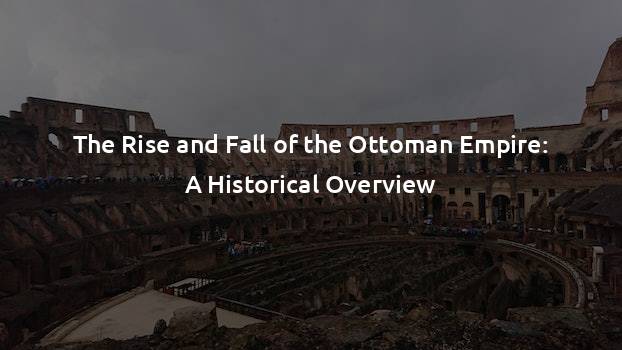The Rise and Fall of the Ottoman Empire: A Historical Overview
The Rise and Fall of the Ottoman Empire: A Historical Overview
The Ottoman Empire, also known as the Turkish Empire, was a vast and powerful state that existed from the 13th century to the early 20th century. This empire spanned three continents, including much of Southeastern Europe, Western Asia, and North Africa. With a rich and complex history, the Ottoman Empire significantly impacted the world, leaving behind a lasting legacy. This article provides a historical overview of the rise and fall of this influential empire.
The Rise of the Ottoman Empire
The Ottoman Empire originated in the small Anatolian region of present-day Turkey. In the late 13th century, a tribal leader named Osman I established a dynasty that would eventually grow into a powerful empire. Osman and his successors expanded their territories through military conquests, establishing a state known as the Ottoman Beylik.
Under the leadership of Sultan Mehmed the Conqueror, the Ottomans achieved one of their most significant milestones: the capture of Constantinople in 1453. This victory marked the end of the Byzantine Empire and solidified the Ottomans’ position as a dominant force in the region. They renamed the city Istanbul and made it their capital, transforming it into a flourishing center of culture, trade, and politics.
Over the next few centuries, the Ottomans continued their expansion, conquering vast territories across Europe, Asia, and Africa. Led by skilled military leaders and employing innovative tactics, they established themselves as an empire feared by many. By the 16th century, the Ottoman Empire reached its peak, controlling a vast area that stretched from Hungary in the west to Iraq in the east.
The Zenith of Ottoman Power
During its zenith, the Ottoman Empire enjoyed a period of great prosperity and cultural flourishing. Sultan Suleiman the Magnificent, often considered one of the greatest Ottoman rulers, presided over this golden age. He expanded the empire’s territories, instituting reforms, and promoting cultural advancements.
Under Suleiman’s leadership, the Ottomans reached the height of their military might, conquering strategic territories such as Rhodes, Belgrade, and Budapest. Their navy, known as the Ottoman Fleet, dominated the Mediterranean, extending their influence across the seas.
This period was also marked by significant advancements in art, architecture, and literature. The empire became a hub of architectural marvels, with grand mosques and palaces adorning the cities. Ottoman art, influenced by diverse cultures, incorporated intricate calligraphy, geometric patterns, and exquisite ceramic craftsmanship.
The Decline and Fall of the Ottoman Empire
Despite its impressive achievements, the Ottoman Empire began to decline in the late 17th century. Several factors contributed to its downfall. One significant reason was the internal strife caused by the Ottoman inheritance system, which often resulted in power struggles and weak successors. This weakened central authority and led to corruption and inefficiency within the empire.
Furthermore, the empire faced external challenges from European powers. The rise of powerful nation-states such as Austria, Russia, and Britain posed a threat to the Ottomans’ dominance. These European powers competed for control of strategic territories and sought to limit the empire’s influence.
The Ottoman Empire also began to lose territories through a series of military defeats. The decline became evident in the late 17th century with defeats against the Habsburgs and the loss of several key strongholds. The empire faced further losses in the 18th and 19th centuries, particularly during the Russo-Ottoman wars, as Russia expanded into Ottoman territories.
In the late 19th century, the empire’s increasingly desperate attempts at reform proved unsuccessful. Internal divisions based on religion, nationalism, and ethnic tensions arose. These divisions led to uprisings and revolts within the empire, particularly in the Balkans, where various ethnic groups sought independence.
The Collapse and Legacy
The First World War proved to be the final blow to the crumbling Ottoman Empire. The empire sided with the Central Powers, leading to its defeat and dismemberment by the Allied powers. With the empire dissolved, the modern nation of Turkey emerged, led by Mustafa Kemal Atatürk, who established a secular and nationalist state.
The legacy of the Ottoman Empire remains complex and influential. The empire’s military strategies, administrative systems, and cultural contributions have left a lasting impact on the regions it once ruled. The empire’s religious tolerance allowed for the coexistence of diverse communities, fostering an exchange of ideas and cultural practices.
TLDR; The Ottoman Empire, which existed from the 13th to the early 20th century, rose from a small Anatolian state to a vast empire that spanned three continents. It reached its zenith under Sultan Suleiman, but internal conflicts, external pressures, and military defeats led to its decline and eventual collapse. The empire’s legacy includes its military strategies, architecture, and cultural contributions.







